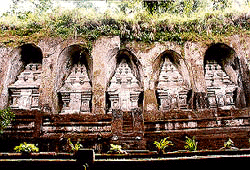
Gunung Kawi
|
|
From the
lookout above a
long stairway, ghostly habitations appear on the far side of the
valley. The young River Pakrisan bubbles down over boulders, as it
winds through the rice terraces. This is the striking setting of Gunung
Kawi, a complex of rock-hewn candis and monks' cells.
|

|
|
Legend has
it that the
gigantic strongman Kebo lwa carved out all the monuments one night with
his fingernails. Remarkably preserved in their deep niches over 7
meters high, they are only facades without interior chambers. There are
ten in all-the main group of five east of the river, a group of four
west of the river, and one by itself at the southern end of the valley.
|
|
Each has a
complex of
monks' cells nearby. The candis however were not places of burial, but
served as memorials to deified royalty. Short inscriptions on some of
the candis have enabled archaeologists to attribute them to the end of
the 11th century, soon after the death of Anak Wungsu in about 1077.
But the identity of the kings and royal spouses honored there has not
been determined with certainty.
|
|
One theory
says the main
group of five candis honored Udayana, his queen, his concubine, and his
two sons, Marakata and Anak Wungsu. Another theory suggests they
honored Anak Wungsu and his royal wives; The group of four candis is
thought to enshrine Anak Wungsu's concubines. The tenth candi honors a
high state official.
|
|
Perhaps
Anak Wungsu
ordered the Gunung Kawi monuments sculpted at a place where he himself
used to meditate. Similar though smaller rock-hewn candis and monks'
cells have been discovered in other parts of this central heartland of
the Pejeng kffigdom, several of them also on the River Pakrisan. By the
suspension bridge at Campuan, Ubud, are a couple of cells.
|
Copyright
2001-2015, K&D Bali Designs. All rights reserved.
|